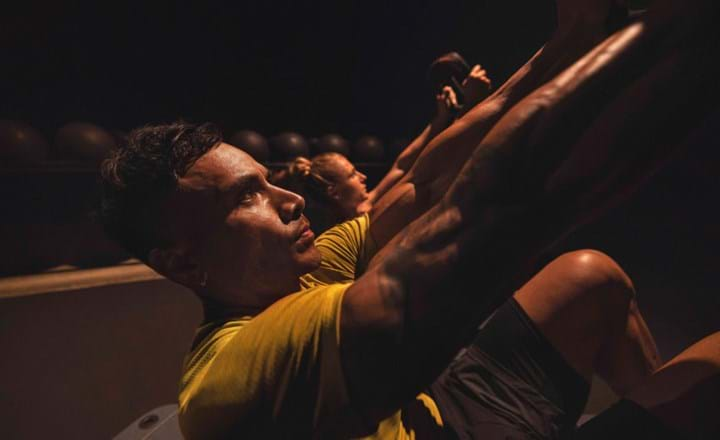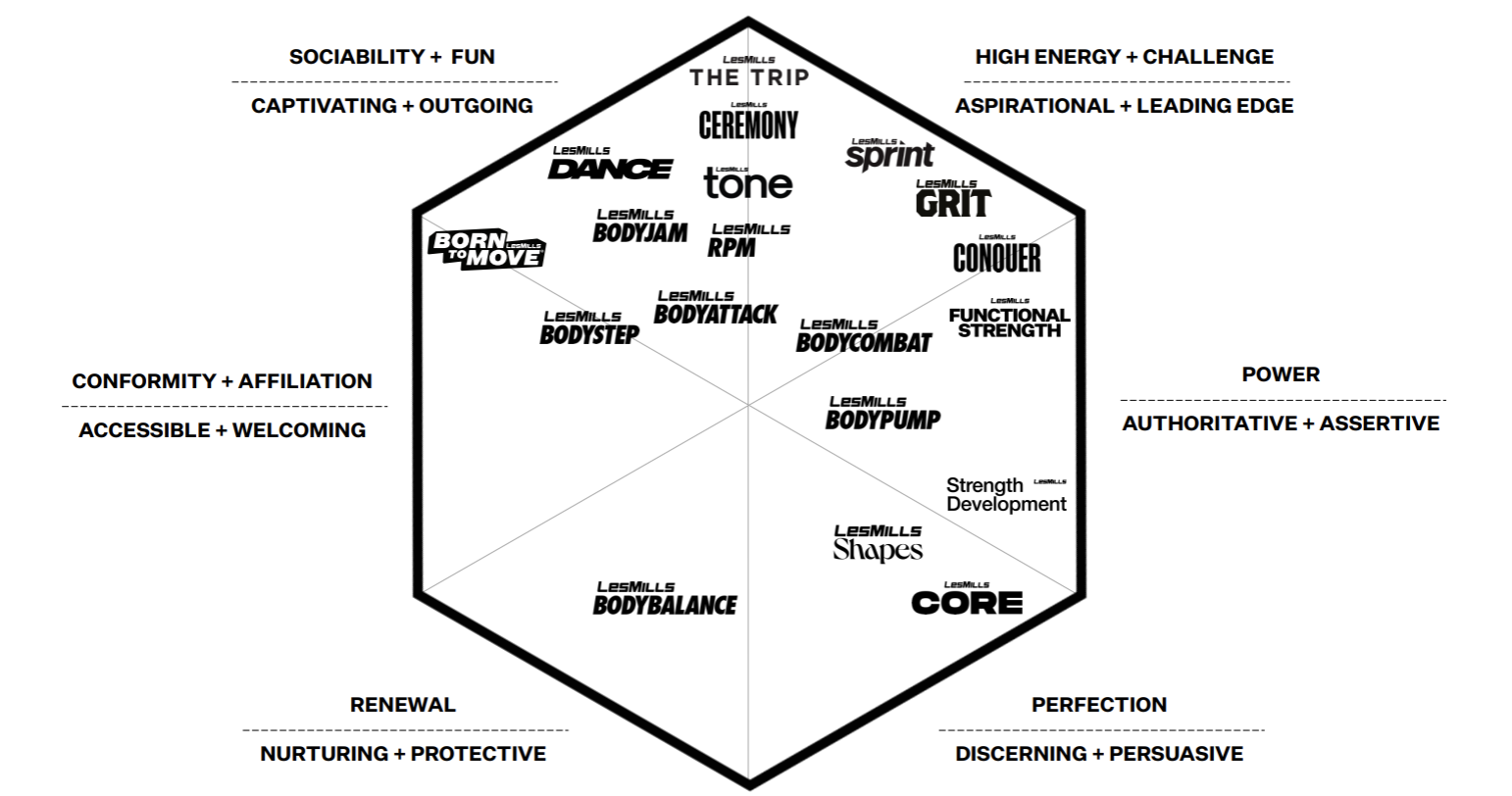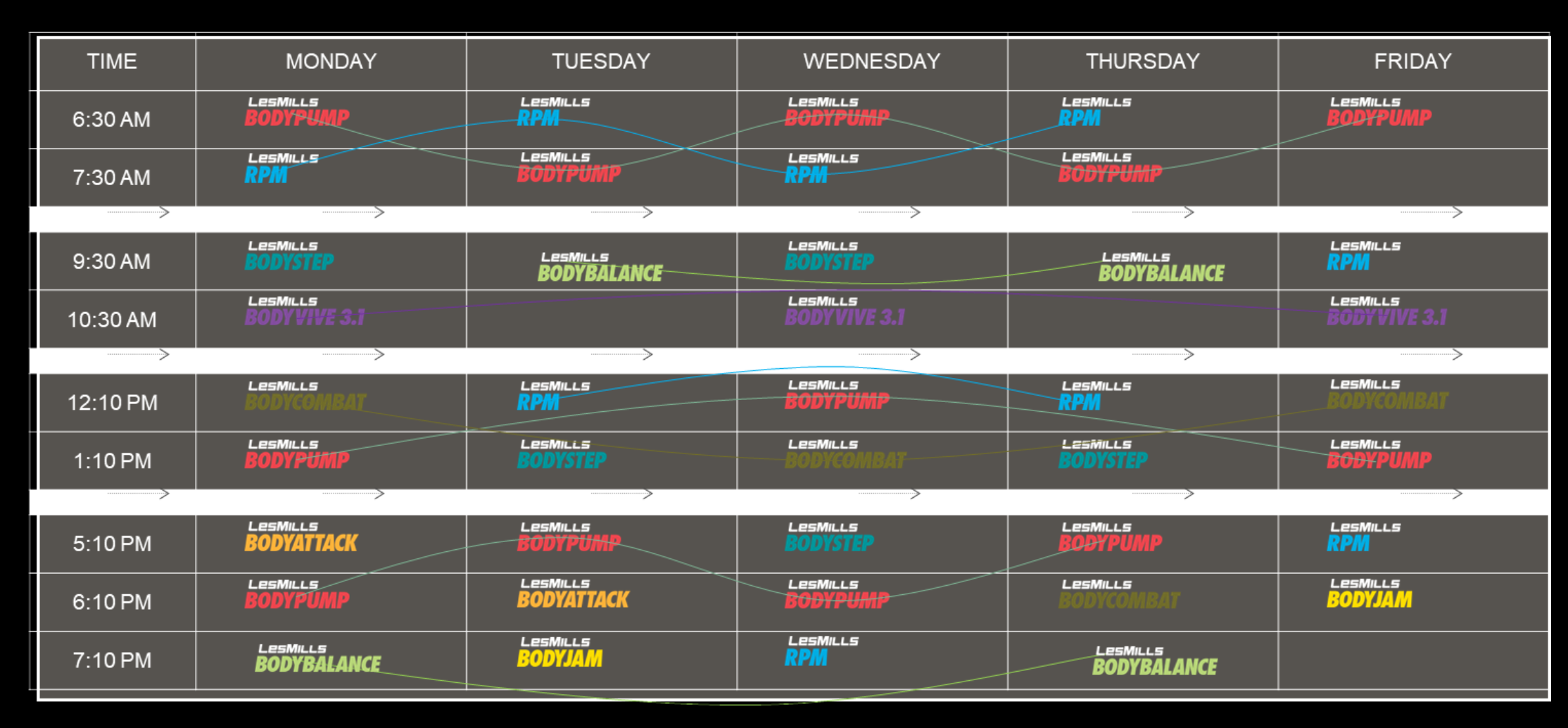
Great planning is central to the success of a club’s studio, whether it’s nurturing rockstar Instructors who can deliver thrilling workouts, right through to curating which classes you offer. This is especially true when it comes to the timetable – a prime piece of club real estate that has the potential to impress (or depress) your members and prospects. Taking time to perfect your schedule can be a key difference maker to a club’s performance. Here are 7 ways to get started:
1. DO THE MATHS
To extract full value from your studio, it’s important to first benchmark how it’s performing. As management consultant Peter Drucker famously said: “You can’t manage what you don’t measure”. By assessing the current state of play, you can identify current strengths and weaknesses, using these to inform your growth targets. As a guide, leading club operators aim to offer classes (Live + Virtual) for 60 to 80% of their total opening hours (see Gold’s Gym example).
Clubs not currently benchmarking group training attendance can approximate their goal by multiplying the average attendees per class, by the amount of classes held per week. As a rule of thumb, weekly group training attendance should roughly equate to your total membership (i.e. a club with 4,000 members should aim for 4,000 visits to classes per week). Leading operators typically see weekly club attendance that’s double the total number of members (so 8,000 visits for the example above), with group training accounting for 50% of total visits.
As some of the group’s largest facilities in the US, Gold's Gym Newburgh and Middletown in New York are renowned for embracing innovation to stay ahead. Owner and managing partner Don Murphy says the broad range of programming on offer is integral to Gold’s continued success: “All the research shows that nailing group fitness is key to driving retention and winning member referrals. It’s not unusual to see 70 people packed into our peak classes. It’s the one thing I think many operators in our industry struggle to fully appreciate – the sheer impact group fitness can have on your business.”
2. QUALITY AND QUANTITY
Making the studio a staple of your members’ training requires sufficient variety to suit their tastes. 64% of Gen Z exercisers say they enjoy choosing different workouts, as well as discovering new ones. In an age of unprecedented choice, modern members expect flexibility when it comes to making fitness purchasing decisions. According to Les Mills Group Fitness Management (GFM) – the seminal training experience for ensuring studio success – offering 8-12 unique class formats on your group training schedule ensures adequate breadth of choice to meet member demands and support your studio goals.
But of course, each operator knows their members best, so the trick is to take this guidance and then pay close attention to class attendance stats to refine the timetable to suit your club’s specific member profile. The most successful facilities offer a combination of the top 8 genres for group training: Strength and Weights, Cardio, Cycle, Mind/Body, Martial Arts, Pilates/Core/Sculpt, Dance, and HIIT. The graphic below illustrates the benefits of each genre and how these meet the needs of certain personality types across your membership. This can be used to support identification of gaps and overlaps on the timetable.

3. PEDAL POWER
Another performance yardstick in the most successful clubs is that the cycle studio should account for 25% of total group training attendance, provided there’s the right frequency of classes and a suitable number of bikes.
Sara Keller, Group Exercise Director at Baltimore (US) based Brick Bodies, has achieved cycle studio success by fostering a super-engaged community. “We’re big on challenges in the studio. We do a distance challenge in the Fall, when participation tends to drop off. Cycle has always been important to us and we continue to invest in it because we know that's what builds our community, and community is a huge part of our brand. We had 53 riders at 6am for a cycle class yesterday. Every available bike was full. We know that 50% of why our members show up is for the workout. The other 50% is because they just want to hang out with their buddy.”
4. PLAY HORIZONTALLY WITH YOUR TIMETABLE
Genre mix is key, but so is providing the right range of timeslots to meet modern members’ need for flexibility. Analyzing your timetable day by day is important, but scheduling horizontally, instead of vertically, is where you win. Horizontal timetabling – as demonstrated by the example below – allows you to be flexible with your timeslots and crucially, broadens the scope of who they attract. If you’re scheduling Strength workouts at the same time every evening, you could be missing out on large swathes of members who can’t make that slot, or others who can only make that slot and would attend more classes if they had varied options. To overcome this challenge, try offering each core program at least two or three times a week within a one to two-hour timeframe.

Natasha Vincent, an International Fitness Presenter and the GFM at Les Mills New Zealand’s Auckland City gym explains how she approached recent timetable changes: “We didn’t touch any of the high-performing classes at all. We left them and then looked at the shoulder classes – those classes sitting either side of those top-performing slots. We looked at both the class numbers, as well as the variety of programs across the week.
“For example, if there’s BODYPUMP™ on at the same time every day, there’s a chance to swap out one of those classes for something else. Many members might only be able to attend the 6pm timeslot, so we want to ensure we’re offering them variety in their training. It’s looking at the timetable horizontally, rather than vertically, and making sure there are plenty of options – i.e. what are we offering at 6pm every day of the week? Will that member get a good mix of training stimuli?”
5. DOUBLE CAPACITY WITH EXPRESS CLASSES
Busy people need training that suits their tight schedules, so it’s no surprise that express classes are becoming more popular as the pace of living continues to quicken. Thinking outside of the standard 45 or 60-minute slot can unlock opportunities to win new class participants with 30-minute express formats.
Sometimes scheduling these classes back to back in place of longer classes can drastically increase capacity and enable you to engage more members. Supporting time-poor parents with express options that wraparound school drop-off or pick-up hours enables them to make the most of their memberships, while midday express slots are a hit with working members on their lunch break.
Express classes also hold potential for attracting and onboarding new members, with the bitesize format ideal for welcoming new faces into the club to sample the atmosphere with a taster workout. Similarly, express classes provide the perfect opportunity to transition digital fitness fans into the live environment: research has found that 35% of Americans now regularly attend a class they first discovered online. Many leading clubs encourage member referrals by offering free taster spots for their friends, giving them the chance to share a social fitness experience in a fun class environment.

6. THINK OUTSIDE OF PEAK
Supporting your peak live slots with Virtual classes is a great way to bolster your timetable and optimize your studio’s usage towards the 60-80% target, without needing to pay extra for Instructors to fill quieter slots.
Virtual can also be a welcoming gateway into the studio for those who are new to group training and want to find their feet away from the intensity of a primetime class. To identify the capacity for virtual workouts at your facility, Les Mills has created a Virtual RoI calculator, designed to measure the increased lifetime value Virtual could offer your club.
Troy Morgan, Group CEO of Willows Health Group installed Les Mills Virtual to support studio growth and optimization. “What we've actually found is that Virtual brings in a lot of new people to group fitness, who weren’t already used to the face-to-face experience,” says Troy.
“The key is to incorporate Virtual into your overall offering and clearly convey exactly how that supplements what your members and staff are already doing. Clear communication is essential to alleviate the fear among group fitness Instructors that they’ll be out of a job – that’s the last thing we would want to happen!”
Troy says Willows are already reaping the rewards of growth: “We’ve got 22 bikes in our cycle studio and in the first five months since implementing LES MILLS Virtual, visits have grown by 26 per cent. So it will be really interesting to see what happens in the long-term now we’ve recently added Virtual in our 30-person main studio as well.”
7. KEEP YOUR TIMETABLE FRESH
An expertly-curated timetable and well-designed studio are vital components to studio success, but it’s the classes that will set member pulses racing – in every sense. The modern member seeks variety, so regularly breathing new life into your timetable with fresh, on-trend programming is essential for building a buzz and driving engagement. The Les Mills Limited Edition Collection delivers bang-on-trend programming – covering key categories such as strength and sculpt – that’s easy to launch and hugely popular. Leading clubs around the world are reaping the rewards of these programs, with many using the innovative formats to generate extra income.
Dutch facility Lifestyle and Health Club Magic recently launched LES MILLS STRENGTH DEVELOPMENT™ – a science-backed, muscle-building workout designed to help members improve power, learn correct technique and build overall confidence in strength training, both in the studio and on the gym floor.
Founder Scott Elder is using the program to provide an intimate, exclusive training experience for members, who pay an additional €249 per course on top of membership fees. Scott says the floor coaching component of the classes gives participants an elevated experience that combines the best of PT and group training to keep them coming back. “We run STRENGTH DEVELOPMENT with a maximum of 12 members per class,” says Scott. “That way we can personalize the coaching based on what each participant requires. And it’s a great add-on for the club, which builds a buzz among members and generates more revenue.”
READY TO UNLEASH YOUR NEXT GENERATION OF MEMBERS?
Les Mills has crafted a new series of programs to meet the specific demands of Gen Z and put your club in the fast-lane for growth.
DISCOVER MORE
